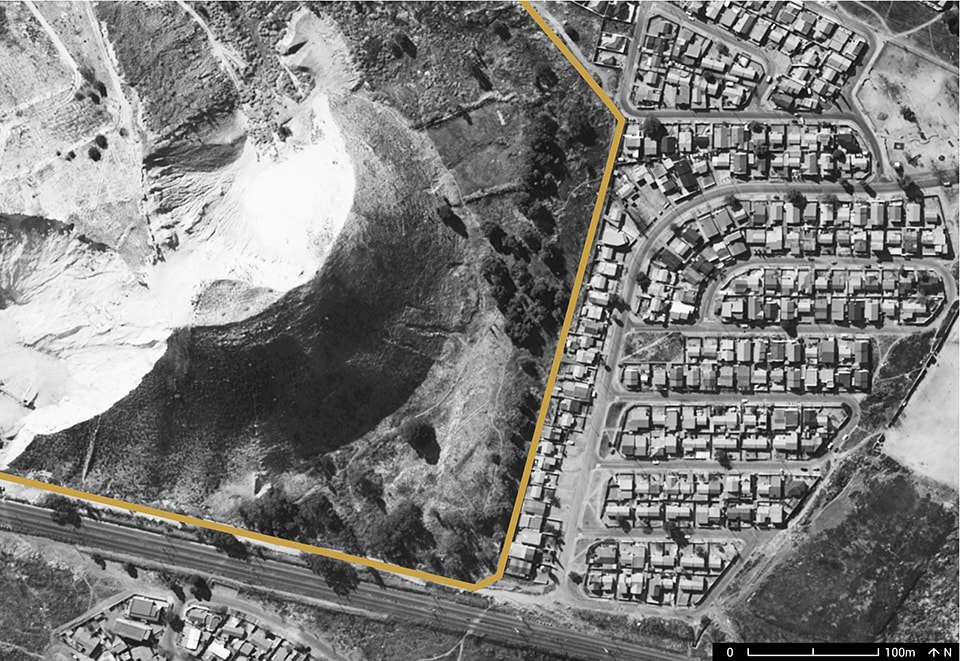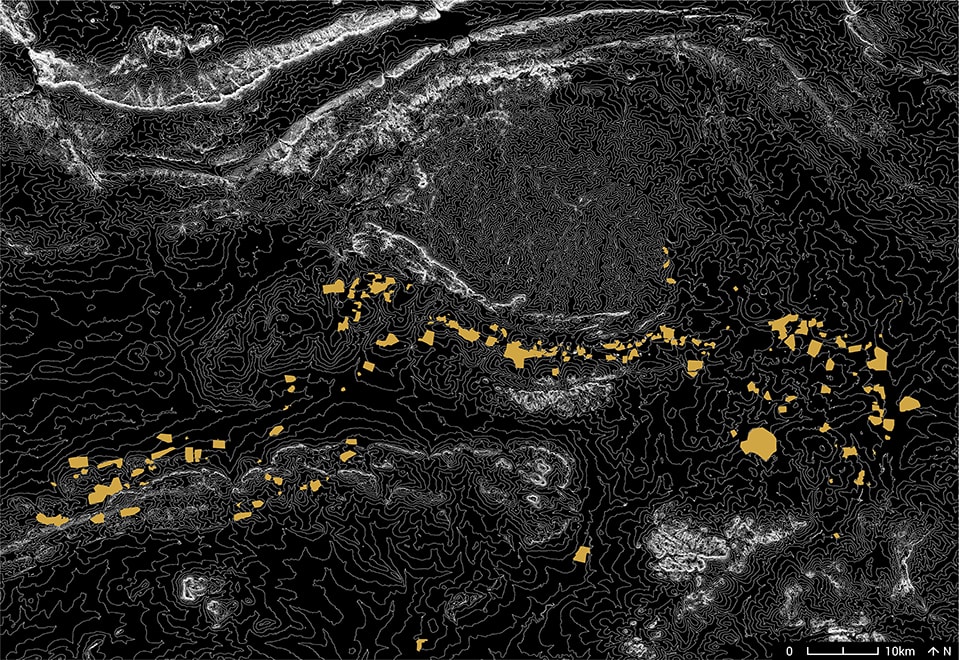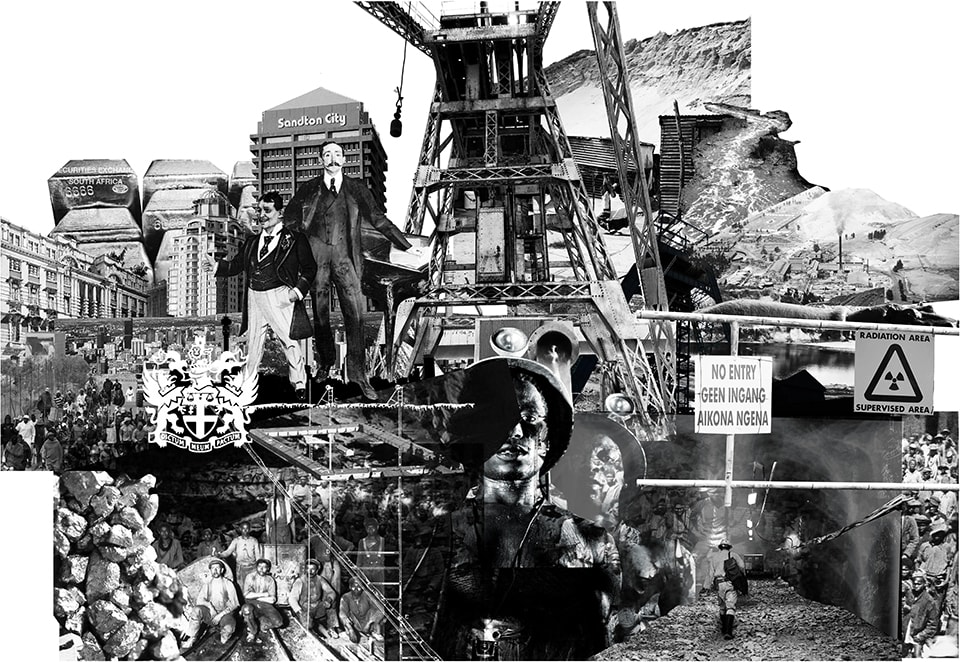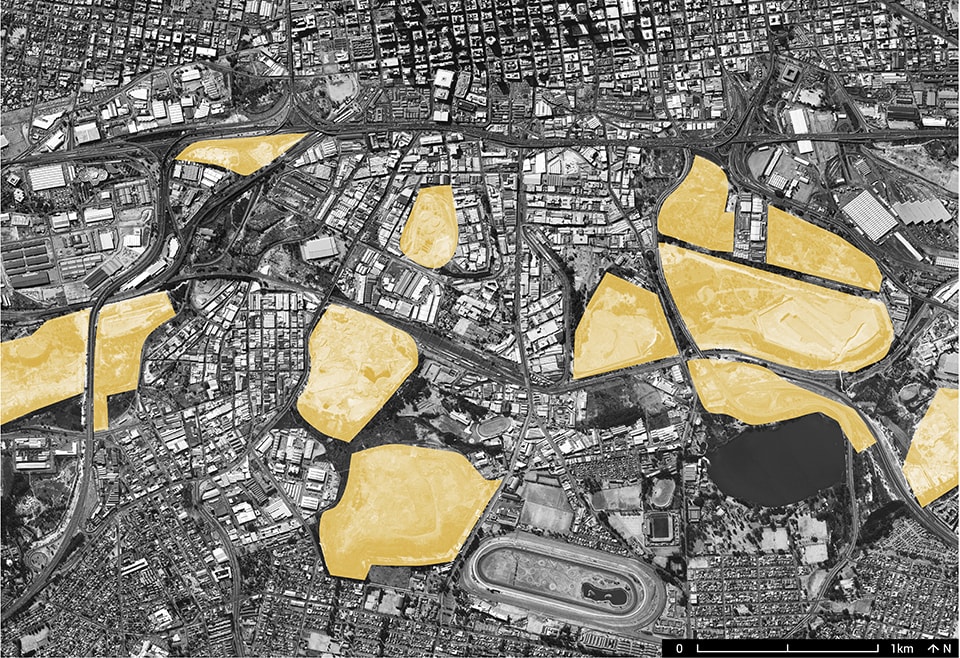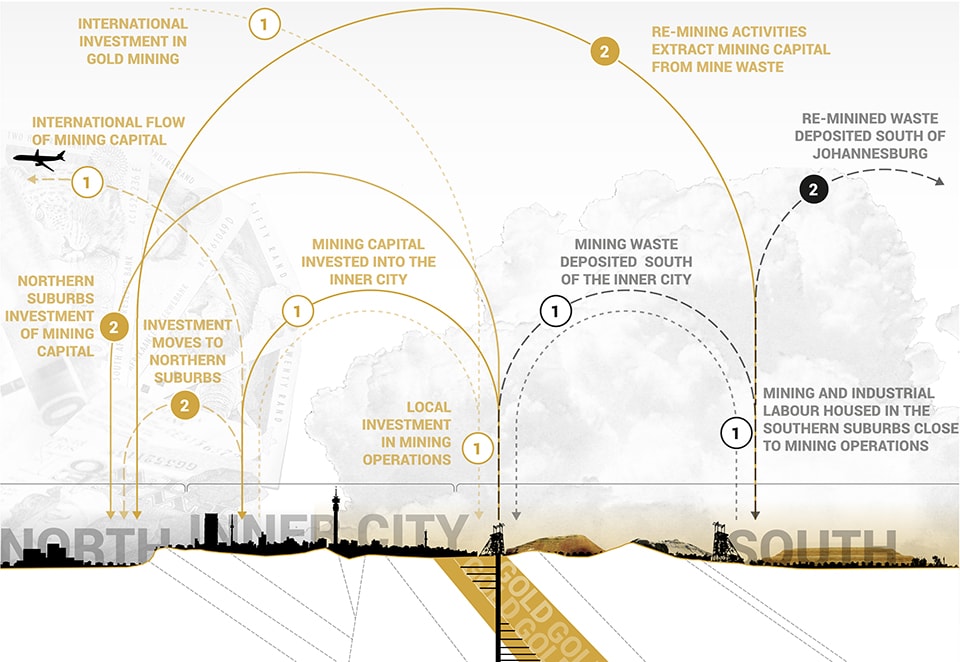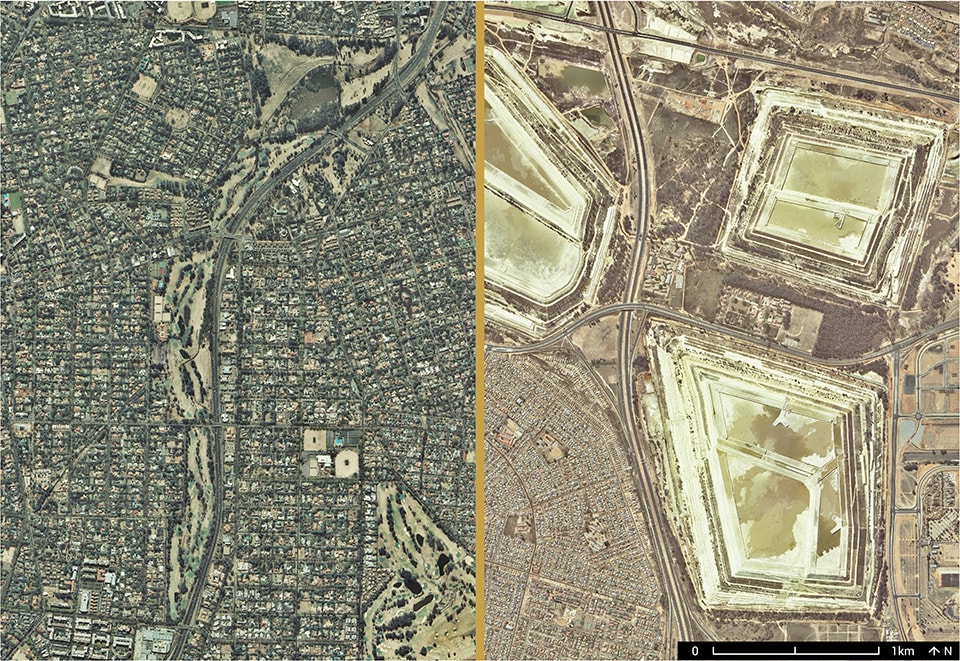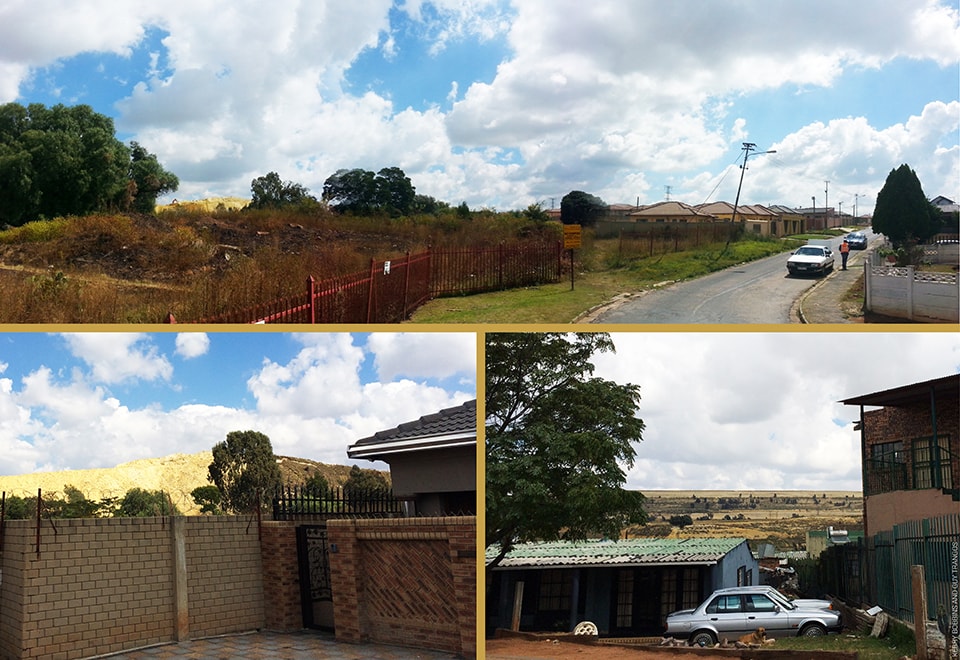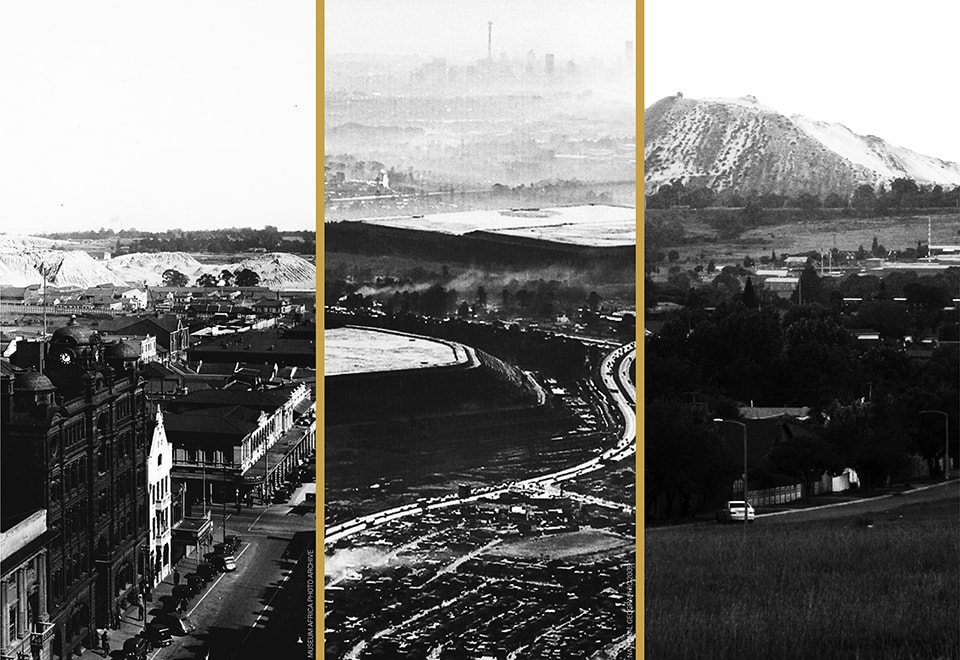Mining activity is a deeply destructive process with consequences that continue to affect many industrial cities around the world. Hinged on extracting wealth and driving down costs to maximise profits, the direct impacts of the physical extraction of minerals and the more nuanced implications of the mining industry on society and the environment create a legacy of disturbance that is far more challenging than a radically altered landscape.
JOHANNESBURG’S SCARRED LANDSCAPE
Few landscapes have seen mining activity on the scale at which it occurs in South Africa’s Gauteng City-Region (GCR). The majority of the GCR falls into the Gauteng Province, the most densely populated province of South Africa, supporting an estimated 12.2 million individuals [1]. The GCR is composed of a cluster of cities, towns, and urban nodes including Johannesburg and Pretoria. The GCR is also the site of the largest and deepest gold resources in the world [2], a natural asset that has enabled the city-region to become South Africa’s foremost economic engine. From 1970 onwards, gold mining in the GCR rapidly declined, and a shift to a service-oriented economy occurred. Gold mining still happens in Gauteng, and the province is home to the world’s two deepest mines, the Mponeng and TauTona gold mines owned by AngloGold Ashanti, that extend to depths of almost 4km below ground. Diamond, coal and platinum mining still takes place in the greater GCR.
Johannesburg is South Africa’s largest city and one of Africa’s leading urban economies. Situated at the heart of Gauteng, the ‘City of Gold’ has only existed since 1886, when gold was first discovered there. The city’s development was remarkable. Gold was initially found along a rocky outcrop, called the Witwatersrand (‘the ridge of white waters’) that extends in an east-west direction across the central GCR, also known as the ‘Rand’ [3]. The discovery of the world’s largest gold deposit attracted prospectors from all over the world and, within a matter of months, transformed the farmlands and open grass plains that fell along the Rand into a bustling mining town. From the outset, mining activity took place at a rapid rate. Financed by capital from the then declining Kimberly diamond fields, and other circuits of colonial capital, mining on the Rand not only extracted significant wealth from the ground but also instilled deep socio-economic and class divides.
The continual extraction of gold and waste products, generated by increasingly deeper mining operations, has created a landscape that is strewn with large mounds of mine waste and slimes dams. Although mining activity adjacent to Johannesburg has ceased, this landscape of extraction awkwardly intercepts the city’s freeways, human settlements, and ecological systems. The blank zones that remain — created by pockets of uninhabitable mine waste — present challenges for the future development and spatial integration of the city-region.
Traces of historic extraction awkwardly intercepts the city’s freeways, human settlements and ecological systems.
THE CONTEMPORARY LANDSCAPE
An extensive network of abandoned mine shafts and tunnels exist beneath Johannesburg. Today, these spaces are lost to time, and the equipment, signage, supports, and machinery have long been forgotten and abandoned below the surface of the Earth. Degrading slowly, the importance of these hidden subterranean voids have been replaced by the buzz of the city above.
Exploring Johannesburg as a cross section, running in a north-south direction, the city transforms from a landscape of old tree-lined suburbs, once shaped by wealthy mining masters, that frame decentralised economic nodes, to a concrete and vertical inner city defined by the old central business district. Further south, the inner city abuts the remnants of mining activity and is interspersed with light industry, manufacturing and warehouses. This collaged suburban landscape is intersected by the few remaining mine heads, mining outbuildings, mine waste, a prominent municipal rubbish dump and tall blue gum trees, the wood of which was used as props in the mines.
Processes of Extraction: Landscapes of wealth and waste. Diagram depicts historic (1), and modern extraction processes (2) along the Rand
Diverse ecosystems, both natural and constructed, intercept the built urban form of the city, binding it to the surrounding natural network of flora, fauna, soil, water, and air. These essential infrastructures and resources support life in Johannesburg but are constantly threatened by the products of urban lifestyles, industry and mining. On the periphery of the city-region, many areas of great density suddenly emerge. Large apartheid township areas such as KwaThema, Katlehong, Ga-Rankuwa, Kagiso and Orange Farm are located away from social, cultural and economic centres. Dependent on various forms of unreliable public transport, residents of these satellite suburbs are distinctly spatially disadvantaged.
Sites of wealth in the North, and waste in the South
PROCESSES OF EXTRACTION
Despite the social and environmental challenges embedded in a landscape polluted by mine waste, the City of Johannesburg would not exist without constant reinvestment of mining capital into its urban form and infrastructure. Town Planner Keith Beavon refers to the early fortunes, booms, slumps, and turnarounds of the SA economy due to gold production from 1886, until its eventual decline in the 1970s [4]. This economic uncertainty was the result of limitations on the production of gold, such as the fixed gold price, low gold grade, inefficient technology, and political instability. Despite these limitations, influential moments in the City of Johannesburg’s gold mining history associated with technological advances to extract gold from deeper belowground, the sourcing of cheap labour, and the securing of a sustainable water source, allowed for profitable mining to continue along the Rand, generating the necessary funds for the constant reinvestment of mining capital into its urban form and infrastructure.
The Rand yielded over 47,000 tonnes of gold between 1886 and 2002, which is also said to represent between 33% and 40% of all gold ever produced globally [5]. Mines kept their operational costs artificially low in order to overcome the unpredictable challenges associated with slim profit margins [6]. This was largely achieved by squeezing out excess costs through irresponsible mining methods, and externalising long-term costs into the hands of third parties wherever possible. As such, the early gold mining economy was reported to be a purely extractive industry with very little consideration for its long-term impacts [7].
For example, as gold mining activity continued along the Rand, mines had to dig deeper — an increasingly expensive exploit — to reach lower-grade gold. During the early years of gold production between 1886 — 1932, the price of gold was fixed on the international market, called the “Gold Standard.” Consequently, gold production costs were minimised through reducing operational and labour costs [8]. The desire to ensure a cheap labour force led to a new set of socially extractive and highly destructive forces for South Africa that manifested in the form of the infamous migrant labour system. Here, mines actively recruited labour from distant rural communities, trapping workers with highly exploitative contracts and working conditions that dramatically limited their freedoms.
The environment itself was also available for easy exploitation. Due to the low grade of gold on the Rand, it is estimated that approximately one ton of ore was extracted from the Earth for every 3 grams of gold produced [9]. Extraction of gold at this grade was simply not financially viable in other parts of the world [10]. Similarly, the vast amount of flat, open space surrounding Johannesburg allowed mine waste to be dumped easily and with limited regard to surrounding ecosystems. Today, a traceable belt of mine waste runs along the 400km-long gold-bearing reef, marking the sites of past extraction.
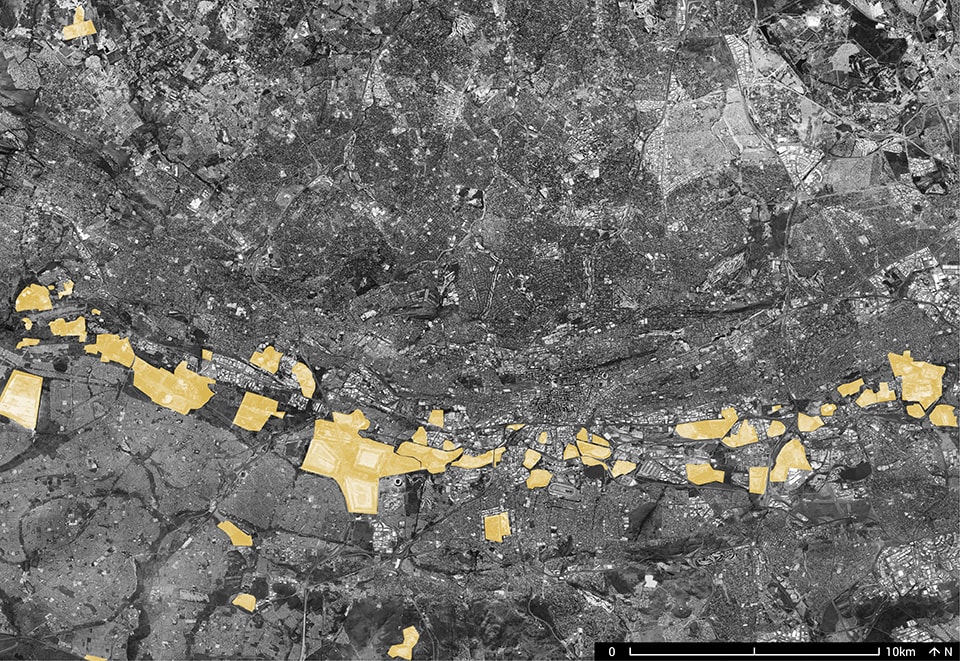 Johannesburg’s mining waste belt
Johannesburg’s mining waste belt
EXTERNALITIES OF AN EXTRACTIVE PROCESS
Mining companies prior to 1991 placed little consideration on their effects on society and the environment [11]. As former mines became unprofitable and were abandoned, mine waste was often left untreated and damaged landscapes un-rehabilitated. Compounded by weak legislation and loopholes, mining companies were able to turn a blind eye to their mining waste responsibilities, leaving behind liabilities that have only become visible long after mining operations have ceased [12]. Mine waste now lies scattered across the city of Johannesburg and its hinterland, polluting common pool resources such as air and water, posing risks to humans and the environment on a daily basis [13]. This, unfortunately, is only a glimpse of South Africa’s mine waste inheritance. It is estimated that across its nine provinces, South Africa has inherited 6,000 ownerless and derelict mines that will cost approximately R30 billion to maintain and rehabilitate [14].
The legacy of extraction still impacts those living adjacent to mine waste
Gold waste produced before 1952 contains elevated levels of uranium, a naturally occurring radioactive metal found along the Rand. Prior to this time, the gold extraction process did not remove uranium found in mined ore and this has subsequently led to contamination through the leaching of uranium from mine waste into the surrounding environment [15]. The lasting consequences of the extraction process still impact the lives of those that live adjacent to mine waste. The health effects of inhaled radioactive particles from mine waste are reported to create toxic effects in the lungs of humans and can be absorbed into the body, leading to radiotoxicity [16].
The close proximity of human settlements to mine waste
While the intricate hydrological system along the Rand can offset localized effects of mine waste on society and the environment by diluting the concentration of contaminants leached from mine waste deposits, it is not sufficient to deal with the full environmental impact of mine waste. In 2002, acidic underground mine water, known as acid mine drainage (AMD) rose to the surface in the western part of Johannesburg and decanted into the natural hydrological system [17]. The increased occurrence of heavy metals and the high acidity of AMD exceeded the natural buffering capabilities of the hydrological system and have left lasting impacts on the environment. The government has put measures in place to partially treat AMD after pumping contaminated water from the underground mine void instead of allowing it to decant on the surface. However, water released into the environment is still heavily loaded with salt, contributing to the increased salinity of watercourses and the broader hydrological network. Until a more sustainable long-term intervention is devised, partially treated AMD is mixed with water earmarked for domestic and industrial use. Due to the limited availability of water in the GCR, this has placed increasing concern on the water security of the region. Similar environmental thresholds have been breached in local ponds and lakes that fall along the Rand that were used as local storage sites for contaminated mine waste. These areas, once considered to be oases along the Rand, have now become sterile landscapes that can support no life [18].
REWORKING OLD SITES OF EXTRACTION
As gold mining in Gauteng reaches the end of its lifespan, the new face of active mining in the province lies in the extraction of diamonds, coal and platinum. As a way to address the extractive legacies of the gold mining industry, initiatives have been put in place to bring new life to old sites of extraction.
Present-day gold re-mining activities along the Rand reprocess mine waste to extract further profits from the now-expired mining industry and serve revived sites of extraction. For example, a mining company located on Gauteng’s West Rand has bought rights to the waste deposits of historic gold mines in order to reclaim fragments of gold that remain in mine waste deposits. While doing so, they rehabilitate the remaining land after reclamation and prepare it for re-development. Such ventures are undertaken primarily by the private sector through a small number of developers who work these territories for their own profit. These projects not only transform the physical landscape, but have also begun to alter the incurable relationship that exists between mining houses and the public sector.
Government funding and expertise has also been directed towards the development of alternative futures for the city-region. One example is the Gauteng Department of Agricultural and Rural Development’s programme for reclaiming and rehabilitating mine waste landscapes. This programme aims to reclaim Gauteng’s mining waste landscapes as way to preserve the natural functioning of the environment and create new land for housing, food production and the cultivation of biofuel crops or flowers [19]. Another example is the coordinated effort of the South African National Department of Mineral Resources, which has allocated additional funds to rehabilitate 50 ownerless and derelict mines annually from 2014 to 2018 [20].
While alternative visions for past sites of extraction aim to provide a basis for continued intervention and the creation of improved future landscapes, there is often a lack of political will to bring about true change in the public sector, and attempts at true remediation by both the public and private sector are limited. Other fundamental challenges include the costs associated with transforming these spaces for the long term, which creates a fundamental constraint for private sector investment.
CONCLUSION
Landscapes that support natural and constructed ecosystems are much wiser counterparts to landscapes of wealth and waste created by mining. The legacies of extraction have fundamentally shaped parts of Johannesburg’s landscape, society, and ecological systems. The scale and importance of mining on the Rand for the South African economy is considerable, and as such, mining capital has had a direct hand in influencing urban development and growth in other parts of South Africa. Mining capital has also undoubtedly played a radical role in shaping society along racial lines in the city’s early years, which has evolved today into distinct economic divides. This, together with the legacy of apartheid planning, has fragmented Johannesburg’s urban form, distorting the natural landscape, and creating insurmountable barriers to spatial integration, while the mismanagement of waste landscapes has led to environmental disaster in many areas.
Restoring life to the blank zones created by mining waste is critical to achieving a liveable and equitable future city-region. Unless these extractive legacies are addressed, they will remain as obstacles to the city’s urban and social development, creating more intense and compounded legacies for generations to come. Understanding the complex three-dimensional urban ecologies and forces that have guided the extraction process are essential for building alternative futures in these forgotten landscapes.
Guy Trangoš is a professional architect, writer and academic. He is a researcher at the Gauteng City-Region Observatory (GCRO), an organisation established to research the urban complexities of the Gauteng City-Region. The GCRO is a partnership between Gauteng Provincial Government, the University of the Witwatersrand (Wits), the University of Johannesburg and local government, South Africa.
Guy has practiced at both Mashabane Rose Architects and 26’10 south Architects. Today, Guy writes on architecture and urbanism for various publications. His research is centred on changing urban publics, urban mobility, urban design and information design. He holds a MArch (Prof) (Wits), and a MSc City Design and Social Science (LSE).
 Kerry Bobbins is a researcher at the Gauteng City-Region Observatory, a partnership between the University of Johannesburg, the University of the Witwatersrand, Gauteng Provincial Government, and organised local government, South Africa. She graduated from Rhodes University, South Africa, with an MSc in Physical Geography and has completed additional Masters’ courses in International Environmental Policy and Environment and Development from Wageningen University in the Netherlands. Kerry’s research interests include the valuation of environmental infrastructure in urban and non-urban landscapes, provisioning of ecosystem goods and services, water governance and policy, mining impacts on the environment and landscape restoration.
Kerry Bobbins is a researcher at the Gauteng City-Region Observatory, a partnership between the University of Johannesburg, the University of the Witwatersrand, Gauteng Provincial Government, and organised local government, South Africa. She graduated from Rhodes University, South Africa, with an MSc in Physical Geography and has completed additional Masters’ courses in International Environmental Policy and Environment and Development from Wageningen University in the Netherlands. Kerry’s research interests include the valuation of environmental infrastructure in urban and non-urban landscapes, provisioning of ecosystem goods and services, water governance and policy, mining impacts on the environment and landscape restoration.
Notes
